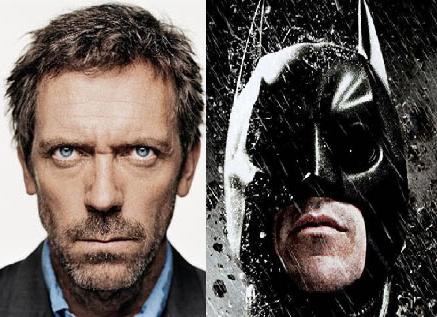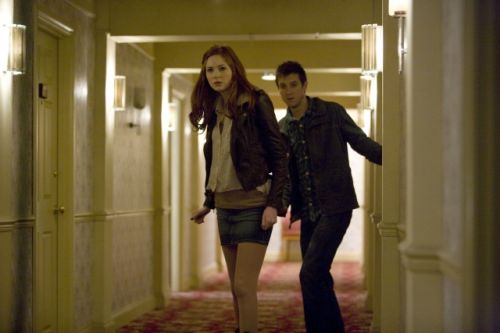 Fiction always has a habit of overlapping, whether intentionally or not, since storytelling is built on only a few choice templates. Your plot can include three headed aliens in an intergalactic pissing contest with ghost humans, or simply be a gritty fable about the perils of alcoholism and social stigma, it doesn’t matter. The plot and setting can go as far as it wants but there will always be links and lines shared. Sometimes, however, spotting that particular connection between the most unlikely of parables is an incredibly bizarre and uncanny experience, especially when a small and superficial similarity reveals much more. A great example would be how a cult-favorite medical TV show seems to share a disconcertingly high number of connections to a recent Hollywood blockbuster.
Fiction always has a habit of overlapping, whether intentionally or not, since storytelling is built on only a few choice templates. Your plot can include three headed aliens in an intergalactic pissing contest with ghost humans, or simply be a gritty fable about the perils of alcoholism and social stigma, it doesn’t matter. The plot and setting can go as far as it wants but there will always be links and lines shared. Sometimes, however, spotting that particular connection between the most unlikely of parables is an incredibly bizarre and uncanny experience, especially when a small and superficial similarity reveals much more. A great example would be how a cult-favorite medical TV show seems to share a disconcertingly high number of connections to a recent Hollywood blockbuster.
Normally when you approach House M.D, Fox’s flash in the pan medical whodunit, the obvious observation to make would be how it is essentially a variant on Sherlock Holmes, with House himself clearly an expy for said great detective (the name is a giveaway) and his team of doctors each representing facets of his muse Watson (with Wilson presenting as his personality). In terms of character, temperament and dysfunction, Arthur Conan Doyle’s greatest legacy lives on in various guises, one of whom spent eight years diagnosing bizarre medical conditions at Princeton-Plainboro. If you go a little further, however, you can discover that another ‘great detective’ who has vague roots in the same original material also shares unnerving amounts of DNA with him, enough to present quite an incredible diagnosis; Gregory House is in fact a modern day superhero. He just doesn’t have a cape. And The Dark Knight Rises holds the proof.
Rather like House treating one of his patients and finally figuring out the obscure disease doing the damage, discerning the unlikely link between one of the biggest blockbusters of all time and a moderately budgeted human drama starts from one small, idle observation that acts as a thread to be pulled. It can be passed off as a coincidence at first, or simply two different stories happening to share the same character archetype, the fractured, tragic hero. Bruce Wayne, upon taking on the cowl and suit, lives a life that is entirely orientated around his crime fighting crusade, to the detriment of himself and any meager hope of happiness he may once have harbored. Gregory House, meanwhile, has an empty and lonely home to call his own and few friends or loved ones to speak of. Like Batman, the one thing he has in his life is the calling, his for medicine. It just so happens that despite being a miserable and miserly figure, he is one of the most gifted doctors on the planet. Whether inspired by the notion of healing (not) or simply the seductive power of mystery (most certainly is), he follows the same framework as any hero. He saves so many lives that he can get away with virtually anything, elevating him to the status of superhuman in a professional sense.
There are other small similarities to note; James Wilson, House’s longest serving and closest friend, effectively serves the same role that Alfred Pennyworth does to Bruce Wayne; House’s reluctant training process for his underlings bears the hallmarks of Batman teaching Robin his ways; at the end of each episode, House saves the day (for the most part) and then returns to his meaningless existence of solitude; his skill for manipulation, analysis and even wonderfully constructed pranks and jokes mirror Batman’s preternatural abilities to outflank his enemies; chances at personal triumph and joy are spurned in favor of his one true mission; House often represents more as a symbol, since many of his patients hear his name, know his craft but never see him in much the same way Batman does. These are passable, however, once again a symptom of the anti-superhero status that the protagonist holds. It’s more or less an unwritten role of the sub-genre that the hero cannot be happy or content, and has to face a dichotomy between him or herself and the work they undertake.
More acute are the similarities that emerge with The Dark Knight Rises, Christopher Nolan’s third and final Batman incarnation, and they exist on sub textual and literal levels. Perhaps most notable is the significance of pain. It’s already on record from the makers that each part of the The Dark Knight Trilogy represents a different main theme: Batman Begins is fear, The Dark Knight is chaos, The Dark Knight Rises is pain. By the time of TDKR, both Bruce Wayne and Gregory House share the need for a cane to support themselves, each wracked by personal injury, and both of their lives are defined by pain both physical and emotional. In Bruce’s case, it is the aftereffect of pushing himself too far in the guise as Batman and the death of his dearest friend Rachel Dawes; For House, it is the missing thigh muscle which has left him crippled and the break up from the woman he loved that came as a result.
While Bruce whiles away his days in a depressed stupor within the walls of his manor house, House undertakes his duty before retreating to an empty apartment to be alone with his vicadin pills. Each suffer more and more throughout their respective stories too; while Bruce has his back broken and is left incarcerated, helplessly watching his city tear itself apart, House loses colleagues, friends, family and among other things is shot, beaten, institutionalized, imprisoned and hospitalized by his own hand. The final, deepest cut for him is Wilson being diagnosed with cancer. Pain is the definitive word for both of their lives, and in the latter’s case is summed up beautifully by House’s “life is pain!” tirade at his colleague/student Dr Taub. Despite seeing wonderful things every day, and often being the cause of them, House is overcome by a fatalist levels of cynicism. Much the same can be said of Bruce as he refuses to move on.
Although nuclear bombs and mask wearing super-villains obviously aren’t shared by both universes, the lead up to the closing stages of both tales simply serve their respective plotlines and sense of reality; The Dark Knight Rises sees Bruce overcome his personal demons by taking on the greatest struggle of his life against extraneous dangers. House, meanwhile, sees the good Doctor trying to overcome his personal demons quite literally, and that battle is in of itself the crux of his character arc. The bane of House’s life is himself, not the League of Shadows. Despite being worlds apart in this respect, there are still yet more similarities. In ‘Everybody Dies’, the final episode of the show, House finds himself wounded and trapped in a manifestation of his personal hell, namely a burning building. He is visited by faces from his past, each representing parts of his subconscious. Two of them, Kutner and Amber, are dead. It is a lot like the time Bruce spends in the pit, Bane’s hellhole prison, during which he is visited by a hallucination of the very much passed Ra’s Al Ghul. The same technique shares the same purpose, as both protagonists learn some vital information which they already knew. Escaping this place is the symbolic rebirth for both men.
And here, of course, we come to the biggest overlap of all; how it ends. Although morality is varied in terms of their respective reasons for doing so, both fake their deaths for the sake of themselves, finally deciding to do something to end their spirals of despair. In both cases, their ‘deaths’ are witnessed by sufficient people that they cannot be doubted. Half of Gotham sees the bat disappear over the bay in a nuclear blast, while both Wilson and Foreman watch on as House is engulfed the flames of the collapsing building. In both cases, we then see a montage of the aftermath; there is a funeral for both, in which Wilson/Alfred displays the most emotional pain at the death; the mantle left behind by the dead hero is taken up by a young protégé, respectively Chase and Blake. Then comes the big reveal – not entirely heartless and aware of the damage dying will do the those around them, House and Bruce both leave some gentle hints. Foreman discovers that he is still alive by a slyly placed ID card just as Lucius Fox learns the truth upon finding that the Bat’s autopilot was fixed six moths prior. Both of these are set up in advance, via a short leg on a desk and a previously established software glitch. The biggest one, of course, is Wilson heading to House’s apartment after he receives an enigmatic text and finding the man himself sitting on the stairs waiting for him. This mirrors the way in which Bruce shows himself to Alfred, but also goes further and acts as a strange hybrid between Alfred’s closure and Bruce’s decision to ride off into the sunset with Selina Kyle. It may not be as romantic, but Wilson and House driving off on their motorcycles serves the same purpose (as well as providing a strange visual link to The Dark Knight’s last shot).
The strangest thing about these anomalies is the fact that they are not intentional; The Dark Knight Rises was still filming when the last episode of House was written, and the episode aired while the film was in post-production and two months away from release. Neither crews would have been aware of each other’s plans. While it may simply seem a bizarre coincidence that two of modern pop culture’s most iconic figures would end their journeys in the exact same way, it is also indicative of the fact that the pair are not so far removed. Bruce faked his death to escape the Batman forever, having finally given all he could and finding himself content to retire. House faked his death to escape the misery and hopelessness that his chosen work-first life had created, as well as to get out of jail time and instead be with his best friend before he died. Both acts in of themselves seem selfish and immoral, but are in context justified and heartwarming, while in House’s case, actually incredibly and inspirationally selfless. Yes, his own stupidity, arrogance and self-destruction had necessitated the act, but redemption needs a sin to come first. Their ‘reincarnation’ of sorts represent a breaking of a circle, as well as proving the perfect way to conclude their sagas.
Normally, the furthest anyone would go when analyzing Gregory House would be to say he is just Sherlock Holmes as a doctor, with all the same eccentricity. Calling him a modern day, reality based Healerman seems fanciful until you begin to make a pattern of the hints and tricks present in his character. While he is sarcastic, misanthropic and just plain mean, he is a product of the same kind of lifestyle as the ultimate superhero Batman and is simply displaying different traits. The various shared storytelling techniques, themes and set ups do not merely add up to a bizarre coincidence, they in fact reveal that both characters share the same dilemma and the same grounding in their respective worlds. Ultimately, they prove that, unlikely as it may seem, Dr Gregory House is indeed just as much a superhero.
This has been a strange interpretation…









